In this week’s 5 minute update, we focused on:
1) An analysis of why Russia aggressively went into Syria the first week of October to support Syrian President Bashar Assad. The support of Assad is connected to control and power over natural gas and its pipelines in the Middle East which is rooted in the control and power over natural gas and its pipelines from Russia through the Ukraine into Europe. First, we will examine the control and power over natural gas and its pipelines from Russia through the Ukraine into Europe.
The Russia–Ukraine gas disputes refer to a number of disputes between Ukrainian oil and gas company Naftohaz Ukrayiny and Russian gas supplier Gazprom over natural gas supplies, prices, and debts. These disputes have grown beyond simple business disputes into transnational political issues—involving political leaders from several countries—that threaten natural gas supplies in numerous European countries dependent on natural gas imports from Russian suppliers, which are transported through Ukraine. Russia provides approximately 25% of the natural gas consumed in the European Union; approximately 80% of those exports travel through pipelines across Ukrainian soil prior to arriving in the EU. Important pipelines pass through Ukraine to Slovakia, and then on to Germany, Italy, and Austria. About 60% of Ukraine’s consumed gas comes from Russia. In addition, two-thirds of Gazprom’s revenue comes from the sale of gas that crosses the Ukraine. Germany and Ukraine are Gazprom’s biggest foreign purchasers. Oil and gas trade accounts for half of Russia’s annual export revenue and more than half of Russia’s federal budget.
MAP: RUSSIAN NATURAL GAS PIPELINES THROUGH THE UKRAINE
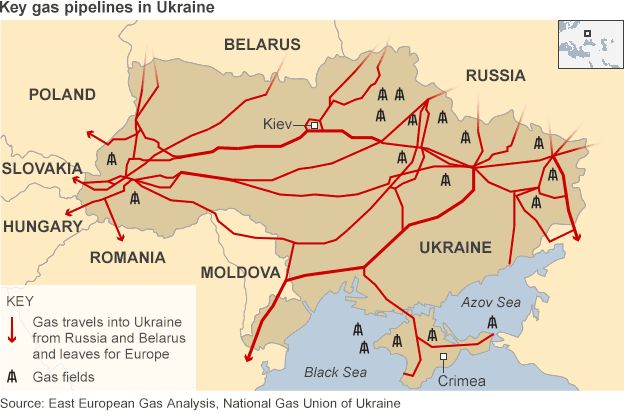
A serious dispute began in March 2005 over the price of natural gas supplied and the cost of transit. During this conflict, Russia claimed Ukraine was not paying for gas, but diverting that which was intended to be exported to the EU from the pipelines. Ukrainian officials at first denied the accusation but later Naftohaz admitted that natural gas intended for other European countries was retained and used for domestic needs. The dispute reached a crescendo on 1 January 2006, when Russia cut off all gas supplies passing through Ukrainian territory. On 4 January 2006, a preliminary agreement between Russia and Ukraine was achieved, and the supply was restored. The situation calmed until October 2007 when new disputes began over Ukrainian gas debts. This led to reduction of gas supplies in March 2008. During the last months of 2008, relations once again became tense when Ukraine and Russia could not agree on the debts owed by Ukraine. In January 2009, this disagreement resulted in supply disruptions in many European nations, with eighteen European countries reporting major drops in or complete cut-offs of their gas supplies transported through Ukraine from Russia.
On 17 January 2009, Russia held an international gas conference in Moscow. Ukraine was represented by the Prime Minister Yulia Tymoshenko. On 18 January 2009, Putin and Tymoshenko reached a deal to restore gas supplies to Europe and Ukraine. Both parties agreed that Ukraine would start paying European prices for its natural gas, less a 20% discount for 2009, and that Ukraine would pay the full European market price starting in 2010. In return for the discounts for 2009, Ukraine agreed to keep its transit fee for Russian gas unchanged in 2009. The two sides also agreed not to use intermediaries. On 19 January 2009, Gazprom CEO Alexei Miller signed an agreement on natural gas supply to Ukraine for the period of 2009-2019. Gas supplies restarted on 20 January 2009, and were fully restored on 21 January. According to the EU Commission and Presidency, the Russia–Ukraine gas disputes caused irreparable and irreversible damage to customers’ confidence in Russia and Ukraine, causing Russia and Ukraine to no longer be regarded as reliable partners. In addition, Russia plans to completely abandon gas supplies to Europe through Ukraine after 2018 by constructing a gas pipeline intended for Europe through Turkey.
Since the break up of the Soviet Union, Ukraine had been mired by years of corruption, mismanagement, lack of economic growth, currency devaluation, and an inability to secure funding from public markets. Since 2004, Ukraine sought to establish closer relations with the European Union (EU) and Russia. One of these measures was an association agreement with the European Union which would provide Ukraine with funds contingent on reforms. The Ukraine–European Union Association Agreement is a treaty between the European Union (EU) and the Ukraine that establishes a political and economic association between the parties. The agreement commits Ukraine to economic, judicial, and financial reforms to converge its policies and legislation to those of the European Union.
The Ukrainian president ultimately refused to sign the agreement at the urging of Russia. Instead, on December 17, 2013, the Ukrainian president signed a treaty and multi-billion dollar loan with Russia whereby it was agreed that Russia would buy $15 billion of Ukrainian Eurobonds and that the cost of Russian natural gas supplied to Ukraine would be lowered to $268 per 1,000 cubic metres (the price was more than $400 at the time). The deal relinquished Ukraine’s Kerch peninsula to the Russian Navy granting Russia highly desirable warm-water ports and strategic access to the Mediterranean and beyond.
Instead of signing a treaty with the EU, Russia wanted the Ukraine to join the Eurasian Customs Union. The Eurasian Customs Union (EACU) is a customs union which consists of the member states of the Eurasian Economic Union. It came into existence on 1 January 2010. Its founding states were Belarus, Kazakhstan and Russia. On 2 January, 2015 it was enlarged to include Armenia. Kyrgyzstan acceded to the EEU on 6 August, 2015. The Customs Union was launched as a first step towards forming a broader European Union-type economic alliance of former Soviet states. The member states continued with economic integration and removed all customs borders between each other after July 2011. On 19 November 2011, the member states put together a joint commission on fostering closer economic ties, planning to create a Eurasian Economic Union by 2015.
Therefore, the present Ukrainian crisis started when pro-Moscow Ukrainian President Viktor Yanukovych’s government abandoned a trade deal with the European Union in favor of stronger ties with Russia. In December, 2013 some 800,000 people rallied in the capital of Kiev and protesters occupy city hall and Independence Square due to Ukrainian president Viktor Yanukovich’s failure to sign the trade deal with the EU. In February, 2014, the Ukrainian president fled Kiev. At that time, the Ukrainian Parliament voted to remove the president from power setting a new election date for May 25, 2014.
After the 2014 revolution, Russia refused to recognize the new interim government, calling the revolution a coup, or an overthrow and illegal seizure of the Ukraine. Russian FM Sergey Lavrov said that the West was inconsistent in not recognizing the Crimea referendum as legitimate while recognizing the military coup in the Ukraine. Lavrov also said that Russia’s relationship with the West has been quite eventful in the post-Soviet period. Lavrov continued: “Russia was welcomed into the democratic world because they expected us to follow their orders and observe all the rules created by the west. However, this is not partnership but rather an attempt to take under control a non-aligned geopolitical ‘turf’. Russia saw that attitude exposed in developments in Ukraine. Russia saw how desperate the West was to drag Ukraine into its orbit, without paying attention to the interests of the Ukrainian economy, culture and the nation. Ukraine is a very complex, multi-ethnic and multicultural country. The ultimate motive behind all that was to separate Ukraine from Russia. Russia remembers the words of former national security advisor Zbigniew Brzezinski under the Carter administration who said in 1998 that with control of the Ukraine that Russia is a great power but without the Ukraine, Russia ceases to be a relevant Eurasian empire.”
In February, 2014, pro-Russian gunmen seize key buildings in the Ukrainian peninsula of Crimea. The majority of Crimea’s 2.3 million population identify themselves as ethnic Russians and speak Russian. Crimea is the historic base of Russia’s Black Sea Fleet. In March, 2014, the Ukrainian peninsula Crimea voted to join Russia in a referendum and Russian president, Vladimir Putin, signed a law incorporating Crimea into Russia. When this happened, the EU and US condemned the annexation of Crimea and imposed a first round of sanctions on Russian officials and high-ranking Moscow allies in the Ukraine.
Ukraine has been torn between east and west since the collapse of the Soviet Union in 1991. Ukrainian is the main language in western regions – where there is also a long-standing aspiration for integration with Europe. However, Russian is predominant in parts of the east and south. In May, 2014, the Donetsk and Luhansk areas of Eastern Ukraine declared independence after a referendum.
MAP: RUSSIAN SPEAKING AREAS OF THE UKRAINE
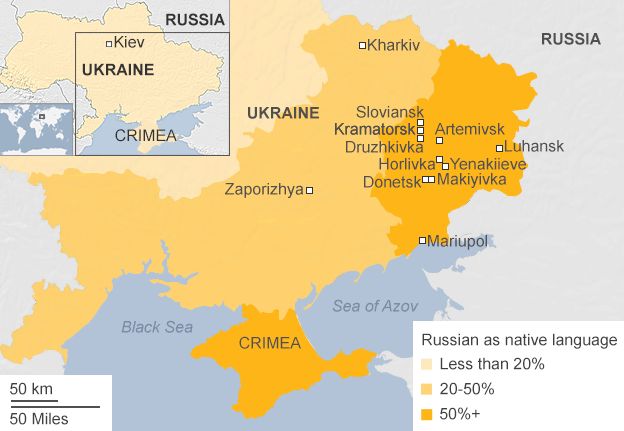
MAP SHOWING THE EASTERN AREAS OF THE UKRAINE INCLUDING THE AREAS OF LUHANSK AND DONETSK WHICH ARE PRO-RUSSIAN
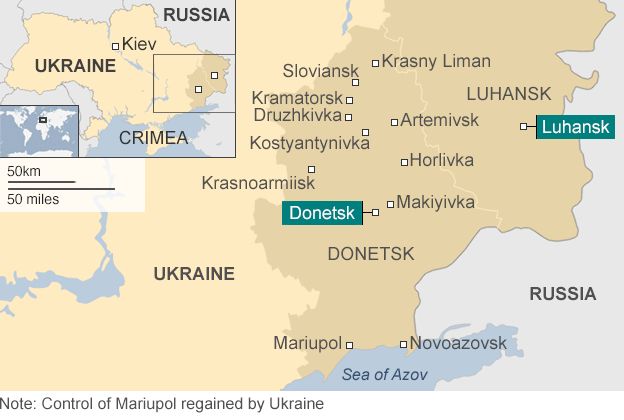
In April, 2014, pro-Russian leaders occupied government buildings in the eastern cities of Donetsk, Luhansk and Kharkiv and declared that referendums on granting greater autonomy to the eastern regions will be held. In May, 2014, pro-Russian separatists in Donetsk and Luhansk declared their independence after the passage of the referendums. The results which were not recognized by the Ukrainian government in Kiev or the West.
MAP SHOWING THE EASTERN AREAS OF UKRAINE WHERE INDEPENDENCE REFERENDUMS HAVE BEEN HELD
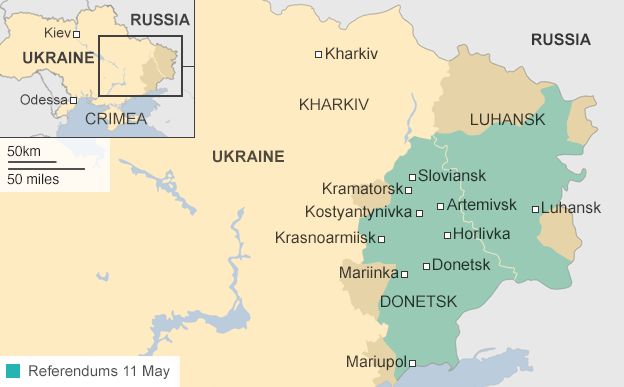
In May, 2014, pro-European Petro Poroshenko was elected president of Ukraine. In June, 2014, Poroshenko signs the trade agreement with Europe. The leaders of Georgia and Moldova also put pens to EU “association agreements” in a historic step for the three former Soviet countries.
In July, 2014, the European Union agrees to punishing economic sanctions restricting access of Russian banks and oil companies to long-term western financing. In addition, the European Union has imposed sanctions against some of Russian President Vladamir Putin’s closest associates within his inner circle.
CHART: SINCE SANCTIONS HAVE BEEN PUT ON RUSSIA, THE RUBLE HAS DROPPED 50% AGAINST THE US DOLLAR

SINCE SANCTIONS HAVE BEEN PUT ON RUSSIA, OIL PRICES HAVE DROPPED OVER 50%
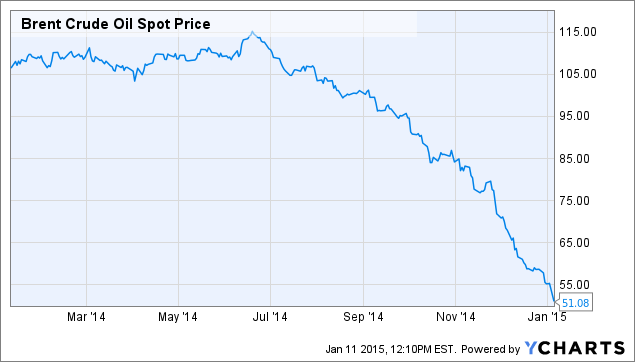
In September, 2014, the pro-Russian rebels in the Eastern areas of the Ukraine, the mainline Ukrainian government in western Ukraine, Russia and the Organization for Security and Cooperation in Europe sign a peace deal in Minsk, Belarus. However, it is violated just four days later when fierce fighting erupts around Donetsk airport.
MAP: AREAS OF PRO-RUSSIAN REBELS CONTROL IN EASTERN UKRAINE
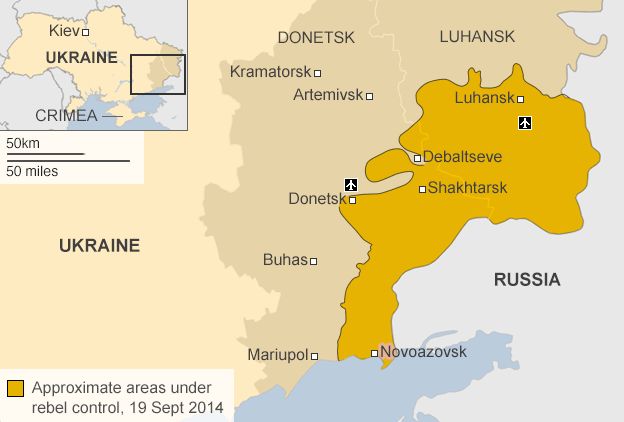
In October, 2014, the western Ukrainians voted for a new parliament. Pro-West parties triumph but the polls were boycotted in the pro-Russian rebel-held east – which held its own elections in November, 2014.
In February, 2015, the leaders of Russia, Ukraine, Germany and France announced that a ceasefire will begin on 15 February. The pro-Russian rebels in eastern Ukraine also sign the agreement. In an interview, Russian President Vladimir Putin dismissed the possibility of war between Russia and Ukraine, calling it unlikely, and made clear that Russia will not be forced to return Crimea to the Ukraine.
Following the successful conclusion of the peace conference, chief of the International Monetary Fund Christine Lagarde announced the organization’s agreement to furnish Kiev with a four-year $40 billion bailout including $17.5 billion to stabilize the country’s economy. Under the terms of the so-called Extended Fund Facility, the Ukrainian government would have to commit itself to trim back on government spending and pensions while tackling corruption and liberalizing energy prices.
In March, 2015, Ukraine and Russia reached an agreement that secures gas supplies to Ukraine for the month of March forestalling anticipated cuts of Russian natural gas supplies to the Ukraine. The agreement is contingent upon Ukrainian prepayment. In advance of the negotiations, Russia had threatened to send gas to rebel-held areas of eastern Ukraine rather than to Ukraine proper. The EU has a special interest in maintaining Russian natural gas supplies to Ukraine as it consumes 40% of Russian natural gas, half of which is transited via the Ukraine. Meanwhile, Ukraine is planning to increase prices of the gas on domestic consumers by “around threefold” to raise funds to avoid government default and meet the IMF demands to seal $17.5 billion. In addition, Ukrainian Foreign Minister Pavlo Klimkin demanded that any mending of fences between Russia and Ukraine would require the return of the annexed Crimean peninsula.
Also, the Russian Foreign Ministry called the arrival of U.S. military trainers in Ukraine a “provocation” that could have considerable consequences as the Obama administration announced that it will send an additional $75 million in non-lethal assistance to the Ukraine. This will include 30 armored Humvees and an additional 300 non-armored Humvees; counter-mortar radar; drones; radios; and medical equipment.
Kremlin spokesperson Dmitry Peskov was unequivocal on the issue of Crimea’s status: “Crimea is a region of the Russian Federation and of course the subject of our regions is not up for discussion.” Peskov was responding to statements from the United States and Europe that sanctions would remain in place as long as Crimea remains under Russian rule – or, in the words of U.S. Department of State spokesperson Jen Psaki “as long as the occupation continues.” In response, Dmitry Peskov said that Russia may alter its fundamental documents, such as the Foreign Policy Concept and Military Doctrine, in response to the perceived anti-Russian bias of the National Security Strategy of the United States.
In April, 2015, the U.S. training mission of Ukrainian soldiers Operation Fearless Guardian was started involving the US Army’s 173rd Airborne Brigade and 900 Ukrainian solders. Also, according Alexei Miller, the CEO of the Russian energy company, Gazprom, said that the government of Ukraine owes his company nearly $175 million for gas supplied to separatist-controlled regions in eastern Ukraine. He also made clear that Gazprom will explore the possibility of signing a separate contract with the so-called people’s republics in those areas to directly supply gas. “The issue should became the subject of special talks, and we think that it’s rational to study the possibility of signing a separate direct Gazprom contract on supplies to the southeast,” he said.
In May, 2015, the European Union stated its desire to implement a free-trade pact with the Ukraine from next year despite Russian pressure for another delay. The agreement which is likely to antagonize Russia, commits to the deal from Jan. 1, 2016, a date already a year later than planned as Russia seeks to oppose European efforts to integrate Ukraine and move it out of Moscow’s sphere of control and influence. The deal is at the heart of tensions that have grown from a tug-of-war over influence in the Ukraine to sanctions, the annexation of Crimea by Russia and armed conflict in eastern Ukraine.
Speaking in an interview on Russian television, Prime Minister Dmitry Medvedev made clear that Russia would not sit idly by if Ukraine defaults on its debt. Medvedev, who was responding to Ukraine’s passage of legislation that would allow a moratorium on debt repayment, stated that in the case of a deliberate default “we would adopt as tough a position as possible […] and defend out national interests.” He went on further to say that Russia seeks not only repayment for the $3 billion Eurobond owed by the previous Ukrainian government but also remains “not indifferent” to debt owed to private creditors.
NATO Secretary General Jens Stoltenberg addressed the “challenge from the east … from a resurgent Russia” and its implications for NATO policy moving forward. Mr. Stoltenberg made clear that he views Russia’s actions in Ukraine not as an isolated incident, but rather as part of a “disturbing pattern of Russian behavior that goes well beyond Ukraine [and] undermines key principles of European security,” foremost among them respect for borders, the independence and sovereignty of states, and transparency in military activities. Stoltenberg further noted that NATO does not seek confrontation with Russia nor does it seek Russia’s isolation; rather, he put forward a vision of a constructive relationship, only to note that such a relationship may be hard to develop as “Russia has changed. And we must adapt.”
In addition, German foreign minister Frank-Walter Steinmeier criticized Russia’s decision to impose a travel ban on nearly 100 European officials in a retaliatory step tied to sanctions over the crisis in Ukraine. Steinmeier stated that the travel ban “does not contribute toward” attempts to work together to “defuse a persistent and dangerous conflict in the middle of Europe,” also calling the move “not particularly clever” as well as arbitrary and unjustified. Russia’s travel ban, which was reportedly delivered to the EU delegation in Moscow, targets 89 officials from across Europe.
In June, 2015, during the opening ceremony of the G7 Summit, President of the United States Barack Obama announced that he and his assembled colleagues would address the urgency of “standing up to Russian aggression” over the course of their consultations, adding, “conflicts can end and great progress is possible.” Shortly thereafter, the White House issued a press release in which it affirmed that “[t]he duration of sanctions should be clearly linked to Russia’s full implementation of the Minsk agreements and respect for Ukraine’s sovereignty.” Furthermore, the European Union governments have agreed to a six-month extension of sanctions against Russia. The agreement will extend the sanctions through January 31, 2016.
Speaking at the St. Petersburg International Economic Forum, Russian president Vladimir Putin placed the blame for the current crisis in Ukraine squarely on the shoulders of Western policymakers in the United States, the European Union and NATO headquarters. He stated that the United States government is at fault of “igniting” the crisis in Ukraine, also noting that Russia sees the United States “interfering with our internal political processes.” Later, he went on to state that the United States is “trying to impose on us their decisions and their standards” without consideration for Russia’s interests, which Putin says Russia is persistent, though not aggressive, in pursuing.
In July, 2015, the United States has added twenty-six individuals and entities to its sanctions blacklist. Among those targeted were were eight associates of Russian businessman and Putin ally Boris Rotenberg, several subsidiaries of Rosneft and Vneshekonombank, and five Crimean port operators. The updaed list also included several associates of billionaire Russian businessman and Putin ally Gennady Timchenko, who was himself hit with sanctions in November 2014.
In September, 2015, Ukraine’s National Security Council gave its stamp of approval to the country’s new military doctrine, a document that declares unequivocally that Russia stands as the principle security threat and military opponent of Ukraine. The doctrine, which still needs to be signed by president Poroshenko, also calls on Ukraine to pursue NATO membership.
Ukraine and Russia, along with EU representatives, initialed a deal that will ensure stable deliveries of gas to Ukraine (and on to Europe) through March 2016. Maros Sefcovic, EU energy commissioner, told journalists that the “winter package” (as the deal is termed) will “lay the ground for smooth gas deliveries from Russia to Ukraine, and consequently also through Ukraine to the European Union.”
In the 1990s, former national security advisor under the Carter administration Zbigniew Brzezinski formulated the strategic case for buttressing the independent statehood of Ukraine, partially as a means to ending a resurgence of the Russian Empire, and to drive Russia toward integration with the West, promoting instead “geopolitical pluralism” in the space of the former Soviet Union. He developed “a plan for Europe” urging the expansion of NATO, making the case for the expansion of NATO to the Baltic states.
In his speech at the United Nations, Russian President Putin rejected the Brzezinski doctrine that seems the West is following today saying that this “bloc thinking” of the Cold War, in his view, remains very alive today in the foreign policies of the United States, NATO, and the West more broadly. The “logic of confrontation” in offering former Soviet countries the false choice of association with East or West, Putin said, resulted in a geopolitical confrontation in Ukraine and a coup “orchestrated from outside” in the Ukraine.
Next week, we will see how the conflict in the Ukraine between Russia, the Ukraine, the EU and the US over natural gas supplies and natural gas pipelines to the Ukraine and Europe is connected to the conflict in Syria to keep or remove Bashar Ashad in power is linked with controlling the routing of natural gas from various Middle East countries through Syria to Europe.
An agreement to divide Jerusalem and establish a PLO state is a tribulation event.
The link to these articles are as follows:
1) Russia–Ukraine gas disputes
2) Ukraine–European Union Association Agreement
3) Eurasian Customs Union
4) 7 December 2013 Ukrainian–Russian action plan
5) To understand what’s really happening in Ukraine, follow the gas lines on this map
6) 2014 Ukrainian revolution
7) Lavrov: If West accepts coup-appointed Kiev govt, it must accept a Russian Crimea
8) Timeline of Crisis in Ukraine
9) Ukraine crisis in maps
10) Ukraine signs historic EU trade pact sparking Russia ire
11) Putin’s inner circle hit by EU sanctions
12) IMF Reveals $40 Billion Bailout Package For Ukraine
13) Putin: War With Ukraine Unlikely, Would Be Apocalyptic
14) Russia and Ukraine Reach Stopgap Gas Deal
15) Klimkin: Russia, Ukraine Normalization Requires Crimea’s Return
16) US Lawmakers Press Obama on Lethal Aid
17) US to Send Additional Non-Lethal Assistance to Ukraine
18) Russia Makes Clear That Crimea Is Non-Negotiable
19) US troops start training Ukrainian infantry
20) Gazprom: Ukraine Owes for Gas Sent to Southeastern Ukraine
21) EU to stand by Ukraine trade deal at summit despite Russia-draft
22) Medvedev: Russia to Adopt “Tough Position” on Ukraine Debt
23) Stoltenberg at CSIS: “Russia has changed”
24) Steinmeier Criticizes Russia Over Travel Ban
25) US President Barack Obama Calls For G7 Unity On Russia, Ukrainian Crisis
26) EU Agrees to Extend Sanctions Against Russia
27) Putin: US Ignited Ukraine Crisis
28) US Slaps New Sanctions on Former Yanukovych Officials, Putin Allies
29) Ukraine Approves New Military Doctrine
30) Ukraine, Russia Reach “Winter Package” Gas Agreement
31) Putin, Obama Discuss Ukraine in UN Speeches
32) The New Great Game: Why Ukraine Matters to So Many Other Nations
33) Who is Zbigniew Brzezinski ?
From a Biblical prophetic perspective, the reason why the God of Israel would allow these events to happen is because it will result in the end of the exile of the house of Jacob and the reunification of the 12 tribes of Israel (Ephraim and Judah).
We will to be “watchmen on the walls of Jerusalem” and we will not rest until the God of Israel makes Jerusalem a praise in the earth (Isaiah 62).
Shalom in Yeshua the Messiah,
Eddie Chumney
Hebraic Heritage Ministries Int’l